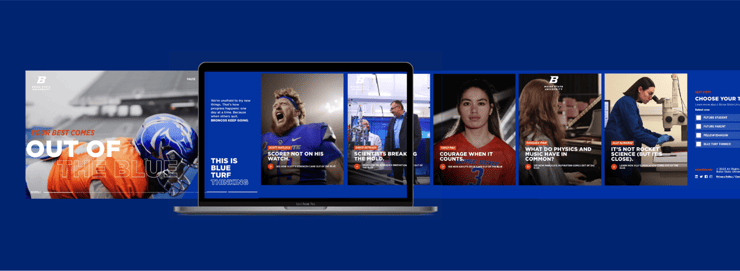Airplane flights are usually a time of reflection for me. Nothing like 4-6 hours tightly packed with a bunch of strangers to clear my head.
My brain was racing when I returned from a few days at the AMA Symposium for the Marketing of Higher Ed. The conference felt "back" in a way that it hadn't since 2018. There was obvious energy and excitement, undoubtedly due to the in-person reunion after three years of a pandemic. And while some of the conference themes were familiar—declining demographics, school closings, crises, or logos—there was much more optimism to look ahead and meet those challenges head-on.
AMA has always been our industry's most important chance to come together, and this year's make-up of professionals and partners seemed different. Nearly a third of the attendees were new to higher ed. While this is common at AMA, these new attendees were not just from central marketing communications; they represented enrollment, colleges, distributed units, and other campus departments. The exhibit hall was also abuzz with various partners and integrated agencies, bumping up with technology platforms, media partners, and specialists that serve specific audiences. The variety of professionals only reinforced what many of us were already well aware of: marketing communications in higher education is as complicated and complex as any industry (and we're generally doing it with only 20 percent of the budget). And while the same marketing and communications challenges exist—budgets, silos, a dearth of technology, and limited professional growth—the path to success seems clear.
The future "winners" among higher ed marketing leaders will be those that can manage the intricacies associated with strong brand management.
Higher ed brand management is, at best, challenging. Universities and colleges continually attempt to differentiate their brands while offering the same services. And as marketing in higher education has matured, the complexity of brand management has increased. It's no longer about logos, guidelines, digital assets, or content management. It's about aligning a brand's efforts with strategic priorities to ensure a solid and consistent message is managed across enterprises, channels, and platforms.
A recent article in the Chronicle of Higher Ed on the influence of rankings noted that, "prestige matters so much in higher education because the industry is the clearest example of what economists and marketers have termed credence goods." Credence goods are "goods and services that are difficult or impossible to evaluate even after you've experienced them. This is true because the consumer lacks the technical expertise or information to judge the quality of the good or service." The challenge, as higher ed marketers know, is that both the brand message and the experience are delivered across a complex web of brand owners, which can break down without a plan for brand management.
Strong brand management is not just a quick fix by a cabinet-level role, organizational change, or some other albatross that ensures 100 percent alignment. It's dependent on organizational will. This sentiment was apparent in the AMA session, "The Chief Constituent Officer," which was moderated by RHB's Rob Zinkan and featured Binti Harvey of Scripps College and Mary Gresch of the University of Washington (both SimpsonScarborough clients, by the way.) Both Harvey and Gresch oversee units that include Advancement and Marketing Communications. Their session's most memorable message was prioritizing the alignment of a shared vision of success across divisions to drive the brand (i.e., brand management):
"Don't think about structure. Think about your expertise and leadership with humility and shared strategy, and then decide on a structure."
Binti Harvey, Scripps College
"I see the power of marketing and communications as driving institutional narrative, storytelling, and bringing the institution with it."
Mary Gresch, University of Washington
The benefits of brand management in higher education are clear. It helps to:
-
Optimize experiences for your stakeholders.
-
Clarify your unique value proposition in a competitive landscape.
-
Attract top talent to your institution.
-
Prioritize support for first-generation students.
-
Present audiences with meaningful content where they spend most of their time (on their phones and apps.)
-
Manage your entire brand landscape across campus (something that a single unit cannot successfully undertake, regardless of institution size.)
The biggest gain in prioritizing brand management is the opportunity to build the brand itself. A focus on performance-based marketing has led to an abundance of direct appeals. Both development and enrollment funnels represent opportunities to reinforce a strong brand at their core. And while the focus is on the response, we might be hitting a performance plateau. There is so much waste in college search marketing and poorly executed direct fundraising. A solidly executed brand management strategy brings the focus back to the brand itself, which can eliminate wasteful marketing efforts and portray an authentic experience to the intended audience. Look no further than the stealth applicant to see the value of brand management in action.
As 2022 comes to a close, higher ed marketing leaders should reflect on what the next year has in store for their institutions. Prioritizing brand management in 2023 can significantly impact a university or college landscape and clarify your value proposition for internal players and external stakeholders.
Branding is already happening daily. It's time to manage it.
—
Jason is CEO & Partner at SimpsonScarborough. Before coming to SimpsonScarborough in 2014, Jason led the marketing communications teams for the University of California System and North Carolina State University. In 2013, he was named Higher Education Marketer of the Year by the American Marketing Association. Known for being our chief Peloton evangelist, he and his wife, Meredith, live in Oakland CA with their daughter, Amelia. Learn more about Jason here.


%20(1).jpg)








